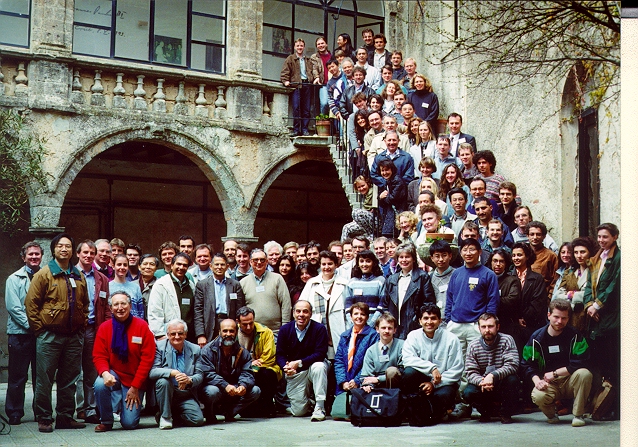


Meeting report
X-ray and Neutron Dynamical Diffraction Theory and Applications

The 23rd International Course of Crystallography, a NATO Advanced Studies Institute held at the Ettore Majorana Centre in Erice, Italy, April 9-21 1996, was organized by A. Authier (France), S. Lagomarsino (Italy), R. Colella (USA), B. K. Tanner (UK), L. Riva di Sanseverino and P. Spadon (Italy). The Course concerned applications of dynamical diffraction using Synchrotron Radiation and attracted a hundred participants from twenty four countries. Besides enjoying nice weather and Marsala wine in the piano room, they listened to lectures, worked hard in the tutorials, and tried computer programs brought by the lecturers.
The first part of the Course reviewed the basic principles of the dynamical diffraction of X-rays and neutrons by perfect and nearly perfect crystals, with special attention to highly asymmetrical cases: polarization of X-rays and various types of crystal polarizers for X-rays and statistical theory for highly imperfect crystals. A great importance was given in the Course to the properties of synchrotron radiation and to the optical devices used in the beamlines which are based on the properties of dynamical diffraction. The theoretical and experimental aspects of magnetic and resonant nuclear scattering of X-rays were also described.
The second part of the Course considered the principles of the various techniques used in the modern applications of dynamical diffraction which are varied in nature. Several contributions were devoted to X-ray and neutron diffraction topography which enables the direct imaging of crystal defects. The various settings were described and the new possibilities opened up by the third generation synchrotron radiation sources were pointed out. The theoretical interpretation of the contrast was given for various types of defects. The main applications presented include the characterization of high technology materials, the in situ study of crystal growth and the relation of crystal defects to the growth conditions, in situ study of plastic deformation and phase transitions, and the analysis of the distribution and shape of domains in magnetic materials. Another technique for the characterization of defects in imperfect materials and the analysis of strains is the high resolution diffraction of X-rays. The theory of reciprocal space mapping was presented in detail and examples of strain-analysis were given in the case of III-V multilayer compounds and ion-implanted silicon. The third type of application described at the Course concerned the location of impurity atoms at crystal surfaces or interfaces by means of the fluorescence emitted at X-ray standing waves antinodes. The same technique is also applied to the study of thin films or long period structures.
Multiple beam diffraction occurs very often in electron diffraction and is usually avoided in X-ray diffraction. The theory for X-rays is complicated due to the fact that electromagnetic waves are vector waves while the wave associated to an electron or a neutron beam is scalar. New developments were presented at the Course relative to the analysis of the n-beam diffraction of X-rays and it was shown that from diffraction profiles in the neighborhood of three-beam diffraction it is possible to determine the absolute phase of structure factors. This may help determine crystal structures of small proteins. Finally, the principles of X-ray and neutron interferometry were described and very promising applications in the fields of phase contrast microscopy and metrology in the nanometer regime were presented.
André Authier

